If you had the option of choosing a Hayward heater or a Raypak heater, which one would you choose? It’s okay if you need more time to do some research before answering. This is just an example of the type of questions our customers usually want answers to.
Owning a pool heater is still a fairly new common practice. The majority of pool owners did not purchase a pool heater ten years ago. For the most part, it was very expensive. They simply tailored their swimming season around their summer seasons and that was that. Today, it is just the opposite. Pool owners are looking for ways to extend their swimming seasons far beyond the last days of summer. The longer the season, the better. As a result, the need for pool heaters grew.
Today, most pool owners don’t need persuasion to purchase a heater. From experience, they simply want recommendations on which heater to purchase. Although we carry a wide variety of pool heaters, customers appear to be most familiar with Hayward and Raypak heaters. In fact, Hayward and Raypak heaters are our most popular heaters to date.
Still, purchasing a pool heater can be a daunting task for most pool owners. At first glance, all pool heaters seem the same, but when you look a little further, you realize each heater has specific benefits and features that may benefit one pool over the other. In other words, what may be the best heater for our customer in Florida may not be the one we recommend to a customer in California.
For our second Product Battle Series, we are determining once and for all, which is better, the Hayward heater or the Raypak heater?

Hayward Universal H-Series
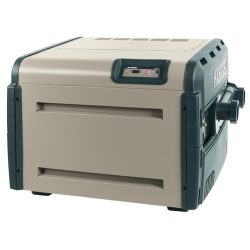 What Hayward Wants You To Know
What Hayward Wants You To Know
The Hayward Universal H-Series gas heater is one of the leading energy-efficient heaters in the industry. What makes it so efficient is the hydraulic design, which reduces the amount of time you have to run the circulation pump. Remember, the less you have to run your equipment, the less energy you’re using, and the more money you’re saving. The new patented polymer header protects against the damaging effects of erosion from high flow or aggressive water chemistry conditions.
Low NOx Emissions
The Universal H-Series heater emits minimal amounts of low NOx emissions into our environment, protecting our atmosphere and qualifying you for any available rebates. This is especially important to pool owners in California who receive extra savings for low NOx heaters. This is also combined with a cupro-nickel heat exchanger, as opposed to Copper. In fact, a low NOx rating and a cupro-nickel heat exchanger do not come standard in most pool heaters. You actually have to purchase a different model. For Hayward, though, this is the standard.
Cupro-nickel Heat Exchanger
A cupro-nickel serves two purposes. First, the cupro-nickel heat exchanger is designed to withstand the harshness of salt over longer periods of time. So, if you have a saltwater generator or plan on getting one, a cupro-nickel heat exchanger is the way to go. A cupro-nickel heater is also a lot more forgiving on pools with fluctuating chemical levels. One of the leading causes of a faulty heat exchanger is chemical corrosion. If you’re one of those pool owners who have a hard time keeping up with the chemicals in your pool, you may want to consider a heater with a cupro-nickel heat exchanger.
The H-Series Standard
The H-Series has a few more cool benefits that set this heater apart from the Raypak heaters. First, it has a forced-air draft system. The forced air draft system prevents the outside temperature from affecting the total efficiency of your heater. In other words, you won’t have to run your heater longer just because it’s cold or windy outside. You can actually track your current water temperature and how efficient your heater is directly from the L.E.D. control panel. The L.E.D. control panel also provides a digital temperature readout, diagnostics, and an electronic ‘lockout’ of temperature set point.
The Hayward Universal H-Series heater is universal, making it a perfect option for new and existing pool and spa applications. The gas and water connections can rotate to both the left and right sides of the heater, making it flexible for any installation.
What also sets the Hayward heater apart from the Raypak heater is that all of the features come in the most standard model. You don’t have to worry about picking the wrong model or paying more for a particular model just because of its features.
Features and Benefits
- Energy-efficient with 18% in savings
- 2″ x 2.5″ CPVC unions
- Common union for installation or service and adapts to larger plumbing
- Standard cupro-nickel heat exchanger
- Low NOx emissions meet all clean air quality standards
- Available in a wide variety of sizes (150k-500k BTUs)
- Patented bypass design for superior hydraulic performance
- Forced draft system
- L.E.D. control panel
- Dual Voltage
- Silicone nitride ignition switch
Technical Specifications
Related Links
Employee Comments & Reviews
Employee #1: Overall, I hear few complaints about the Hayward heaters but when I do it’s usually about the upfront price of the heater and that the wiring for the install is a bit complicated.
Employee #2: When I owned my business, the Hayward heater was more common than the Raypak heaters. Hayward has a very small environmental footprint and has easy access to replacement parts.
Employee #3: With Hayward, you are paying for the upgraded options. Ask yourself, do you need or want these options?
Employee #4: Make sure you hire a professional to wire your Hayward heater. You have to actually move a particular plug on the heater and failing to do so increases the chances of frying your heater.
Employee #5: Consider what you are paying for. With Hayward, you are paying for upgraded options.
Customer Reviews
Customer # 1: The price was reasonable for the features I needed for my pool.
Customer #2: No cons right now. I like that I can easily convert to natural gas if I need to.
Customer #3: If you purchase a Hayward heater, make sure you call Hayward to locate a recommended installer. They do the best work and secure your warranty with Hayward.
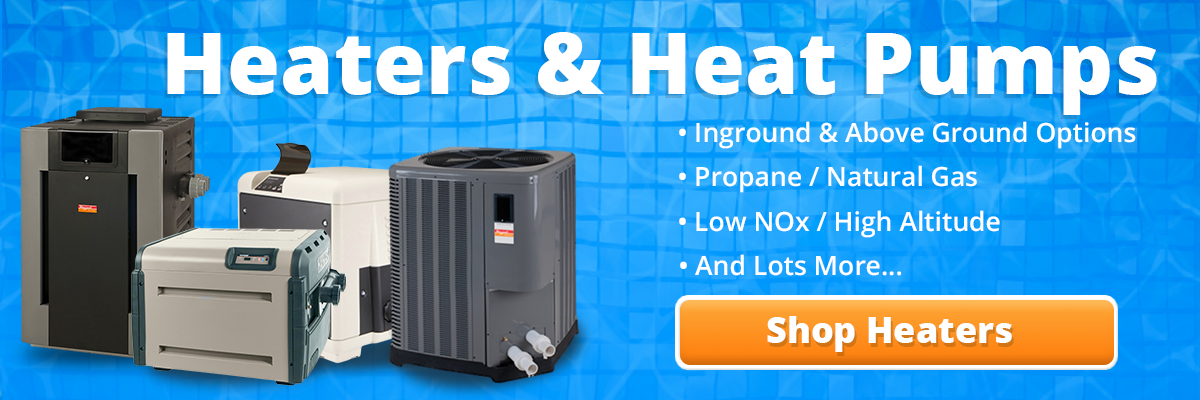
Raypak 2100 Series
What Raypak Wants You To Know
What makes Raypak so popular is their parent company, Rheem. Rheem is one of the nation’s leading manufacturers that produces residential and commercial water heaters, boilers, air conditioning, and ventilating systems. One of the reasons why the Raypak brand is so popular is because of the familiarity with the Rheem brand.
Raypak has proven to be a reliable, affordable heater for pool owners across the nation. Raypak offers a complete line of residential pool and spa heaters that fit into almost any application and situation. Unlike the Hayward H-Series heaters, the standard residential Raypak heater does not come with Low NOx emissions nor a cupro-nickel heat exchanger. Don’t fret, though, Raypak does offer a heater with Low NOx capabilities and one with a cupro-nickel heater. A low NOx rated or cupro-nickel heater costs more than the standard Raypak heater and is a completely different model than the standard heater.
Still, the standard Raypak heater is still one of the best-selling heaters we carry.
Control Systems
The Raypak heater has a microprocessor-controlled thermostat. The thermostat on the heater allows you to precisely set your temperature by simply pressing the up and down button in the preferred setting. The thermostat displays the heating process and alerts you once the pool reaches the desired temperature.
Raypak also utilizes an on-board diagnostic control for their heater. It displays exactly what is wrong with the heater in plain English and not in a code you have to decipher. Trust us when we say, heater error codes are no fun. Another cool thing about Raypak heater is its ability to record how long the heater runs and how many times it fires. This is an industry first. It provides valuable feedback for service professionals during maintenance or repair. Raypak heaters are also compatible with most popular and mainstream remote control systems on the market. Pretty much any two or three-wire remote has the ability to integrate into Raypak heaters.
Copper Heat Exchanger
The standard Raypak heater comes with a copper heat exchanger. The engineered Unitherm Governor sets this heat exchanger apart from other copper ones. The governor controls the temperature and flow rate in the heater, eliminating condensation, soot, and scale build-up. It is safe for you to use a copper heat exchanger on a salt pool. However, it is less forgiving in pools with fluctuating chemical levels.
Flame & Burners
The Raypak heater consists of stainless steel burners that self-adjusts to compensate fluctuating gas pressure. They are easily removable and serviceable. Raypak also includes a “spark to pilot” ignition system that helps guarantee the heater stays lit.
One of the biggest concerns for heaters with pilot flames is their reluctance to stay lit. Well, Raypak has found a way to relieve some of those worries. Raypak heaters are the first to monitor and measure the pilot flame signal. This is called the flame strength indicator. Raypak took a feature on most commercial pools and applied it to residential pools. In essence, this is a service man’s dream. Raypak also uses this feature to test heaters before they even leave the factory.
Onboard Voltmeter
The onboard voltmeter monitors the low voltage electrical supply. This ensures the heater is wired properly during the initial installation. It also lets you know if the voltage dropped too low for the heater to properly function.
Raypak Models
High Altitude Heaters
Pool owners located above sea level must purchase a high altitude heater. Failing to do so will cause your heater to act in a defective manner. The issue is not the heater but the low oxygen levels. All gas appliances, including pool heaters, need fresh air containing oxygen for complete combustion. The higher you go above sea level, the less oxygen is in the air, and the more likely your heater will not function.
The Raypak High Altitude residential heaters handle elevation levels as high as 9,000 feet but only uses natural gas.
Cupro-Nickel Heaters
The Raypak heater has cupro-nickel fin tube heat exchangers for added protection against aggressive water chemistry. Although rare, there are applications like health club spas, where copper is just not the best choice. Cupro-nickel offers superior tolerance to bad or fluctuating water chemistry. Its fins have a harder surface and thicker walled fin tube. Unlike the high-altitude models, the cupro-nickel heaters use both propane and natural gas.
Low-NOx
Low-Nox heaters are a more environmentally safe way to heat your pool. They use combustion control to minimize levels of nitrogen oxide (Low-NOx). This controls a number of emissions released from the heater into the atmosphere. Low-NOx heaters also comply with California Air Quality Emissions Standards and qualify for state rebates as well. The Raypak low-NOx model comes in four sizes, includes a copper fin tube heat exchanger, and available in natural gas only.
Features & Benefits
- LCD digital display provides accurate temperature
- Dial control for temperature selection and heater settings
- Monitors operational status and service diagnostics
- High-wind resistance
- Corrosion-resistant headers
- Unitherm governor prevents condensation
- 2″ PVC threaded union plumbed directly to heater
- Can be installed on combustible surfaces
- Thermal efficiency of 83%
Technical Specifications
Related Links:
Employee Comments & Reviews
Employee #1: I honestly prefer the Raypak over the Hayward because of the price and reliability. It makes no sense to purchase a heater for the name to justify the price.
Employee #2: I tend to recommend the Raypak because it has more customizable options. It’s also manufactured by the leader in residential HVAC. The powder-coated steel exterior will never fail.
Employee #3: The Raypak heaters are easier to install because it has simple wiring. It also has the same plumbing as Jandy heaters, making it a great replacement, as well.
Employee #4: The Raypak units are flexible in terms of gas pressure thru the hex. It also has fewer parts for replacement or that could break.
Employee #5: Depending on the space, I would go with the Raypak heater.

Customer Reviews
Customer # 1: The electronic controls are easy to use and easy to maintain water temperature at setpoint. The electronic ignition never fails. The polymer headers, the slip fittings, and flange nuts made piping installation simple.
Customer #2: So far we are very pleased with the performance of the Raypak heater. We live in the Midwest and open our pool in mid-April and we don’t close to mid-October, so we use the heater a lot. It heats quickly and seems to be efficient. So far no cons.
Customer #3: This is our 2nd RP2100, the first lasted over 10 years, but rotted out after hurricane Sandy. Now that Rheem has purchased RayPak, the quality of the unit is noticeably higher and much improved. It still aligns 1:1 with the old units, but most all common problems have been addressed. One caveat for all pool heater owners. You must put a check valve out the output side of your heater to ensure that chlorine from the chlorinator does not pull back into the heater when the pump goes off. That will destroy the heat exchanger in a short period of time. If you do have a check valve, make sure to open and inspect it at the start of the season to make sure it is sealing properly
Customer #4: Parts are easy to replace, it was a near drop-in replacement for my old one. Get the largest BYU output you can afford. I went from the 333K to the 415K and I am super happy with the extra heat and efficiency
Customer #5: Cons – I can’t read the display unless I lift open the door (That really bothers me because I can’t read the pool temperature looking over the filter area fence).
Battle 2 Winner: Raypak 2100 Series
Overall, the majority of the feedback I received from customers and coworkers mirrored each other. Sure, both heaters are great units to heat up your pool, however, the overall customization with Raypak is better suited for most customers. With Raypak, you only purchase the features that are necessary for your pool set up. Although the Hayward heater comes fully loaded, not everyone wants or needs the additional services the Hayward heater provides. Yes, we are in the business to make money, but we are not in the business in making you spend unnecessary money. If you were interested in a fully loaded heater, not accounting for cost, then I’d definitely recommend the Hayward heater.
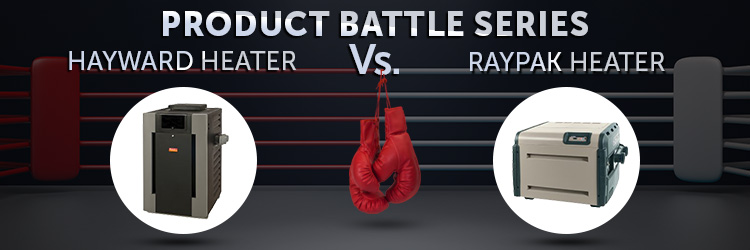

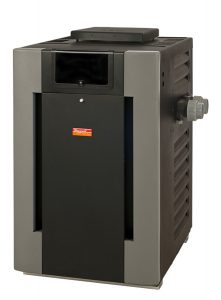

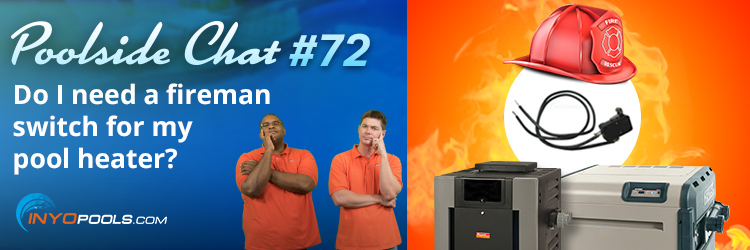
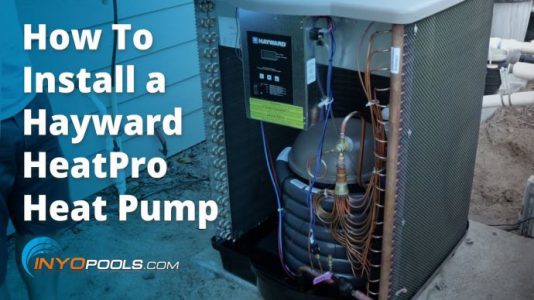
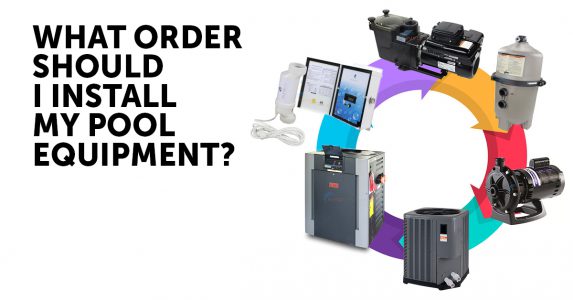
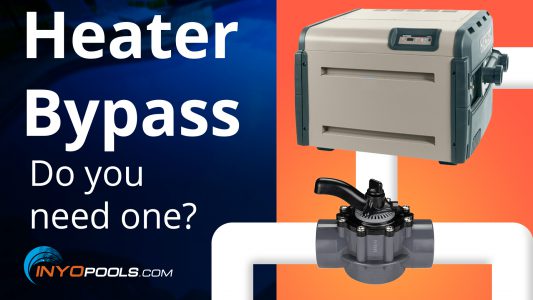






How does the Thermal efficiency of 83% that the Raypak compare to Hayward, Pentair, etc.
Just bought a Raypak PR406AENC49 as the copper has the best rate I could find. Natural Gas
Hayward states their Universal Low Nox Series has an 84% thermal efficiency. Most of the modern copper heat exchangers are going to be within a percentage or two of one another.
How does the Sta Rite Max E therm heater compare vs these Hayward and Raypak Heaters?
It would be third because of the scarcity and cost of the parts. And you will need parts because they are intricately designed; there is a lot of stuff that can fail on those things. If given the choice of taking a Max-E-Therm, I would likely pass.
I’ve owned a Sta Rite Max E Therm 400 for almost 2 years. My pool is about 22,000 gallons. I bought the 400 series which is larger than needed, but more efficient as in the time it takes to heat the pool and maintain the desired temperature. I have had at least 7 service calls so far (my warranty expires April 2024). The heater worked fine for about 5 months. The problem is condensation builds up in the chamber of the heater and the display pad has air bubbles which makes it impossible to program the heater. Once the condensation builds and builds within the heater, consequently the control board is compromised. It’s now a “Ground Hog Day Heater”. Each time we turn the heater on it works for a while then shuts off. The next day we turn the heater on and it works for a while and then shuts off. But wait, then it won’t turn on at all or it won’t turn off and constantly runs and eventually cuts off without programming. Once Pentair sends out the tech to repair. The same old story. To date, we have had three control boards and three display pads replaced! Just got an email stating that they are assigning my warranty call to a fourth vendor. Question to Pentair…how many vendors does it take to realize that I was sold a faulty heater? Meanwhile…I’m looking to purchase a Raypak heater.
Sorry, should have mentioned above in-ground pool is a salt pool.
We just purchased a 40 year old home with a 35 year old gunite in-ground in-door pool. Property had been sitting for about 2 years empty so chemistry probably took the 29 year-old Hayward CZ-200-P1 heater. I’m told I have a 16,000 gallon pool with a 6×6 hot tub that overflows into pool. Looking for advice on best pool heater. The Hayward I’m replacing is currently a 200,000BTU natural gas even though it was originally propane. Don’t want to install too big of a unit (BTU) and not be able to use the hot tub. The fact that the pool is indoors and will be used year round indicates to me that “the larger the better” I keep reading may not apply to my in-ground pool. Once it’s up to temperature, it should not need to be bumped up very often.
I’ve heard Pentair mentioned above. How do they rate in the mix with Raypak and Hayward?
We had a Raypak heater that worked for 16 years with only minor issues. This year the fan went out and instead of replacing the fan at $750, we are going to buy a new heater. Done a lot of research and I am looking at the Raypak ASME low Nox 400 HiAltitude model. I looked at Hayward, Sta-rite & Pentair, but keep coming back to Raypak. I am willing to spend the extra for the better, more durable headers. I figure those will be what’s going to have issues.
I like the variety of models so you can pick the one for your needs and wallet
Raypak is garbage without accountability. Heater only two years old!
Three months of trying to get a resolution to a LEMON Raypak pool heater. Nothing!!!
I’m in the same boat. Took me a year to get a new heater fixed. Lasted a few months, now it’s blowing roll out sensors again. I’m thinking of replacing it with a Hayward. In my experience Raypak is garbage and the support and sales reps are worthless
I know this thread is old but as a trained certified professional pool tech, this isn’t even a comparison. Hayward equipment is absolute garbage period. Raypak and Pentair are miles ahead of Hayward it’s not even funny. The only place Hayward belongs is in the garbage.
Jackson, you are SOOOOOOO right! Original pool installer used all Hayward, but slowly have been replacing with Pentair (Pumps, salt/chlorine generator, remote automation) and Raypak (Heater) and have never been happier! (You cannot kill a Pentair pump.) However, in all fairness, and to be honest, while I did get 13 years out of my original cupronickel Hayward H400 heater (as a CPO, I’m a fanatic about keeping my water chemistry balanced, Saturation Index (SI) ALWAYS +/- 0.5), and I’ve only had my new Raypak R406A heater for less than a year now, the QUALITY and design of the Raypak appears to be far superior. …just my 2 cents, FWIW.
Hi,
I am looking for a propane pool heater for my semi-I ground pool, which is 23 feet diameter.
I want to be able to use the heater sporadically, but with a fast heating results.
I am using a solar heating system, which allow to get 10 degrees higher that normal
That is good for mainly 70 % of the time.
Now I want to get the fastest way to heat my pool , when the weather is too cool before I get to swim.
What should I get? Do you deliver in Quebec?
It is pretty simple, you want a heater that delivers the heat as quickly as possible, get a 400k BTU heater.
Yes, we do ship to Canada.
I would choose anything g EXCEPT Hayward!! Got our pool last year, used the heater a handful of times… IF THAT… went to start it this year and a pipe cracked. We got the IG, ignition failure code and it’s been a nightmare trying to get it fixed. I’m sorry, but a piece of equipment that’s not even a year old and barely used should be 100% covered under warranty. It’s been 3 weeks, still no answers and everyone is playing the blame game pointing the finger between installer and manufacturer. Any reputable company cares more about customer satisfaction. You don’t create a situation where we, the customer, are having buyers remorse over the few hundred dollars it costs to fix the issue. Your crappy heater broke and it’s BRAND NEW! Do the right thing. No home owner wants to dump 30 grand into a pool to have any part of it not work the very next season.
Going through the same exact problems with Raypak. Its a shame for how much they cost.
Same issues
I have a Hayward H-Series heater that never lasts a full season without having to replace Printed Circuit Boards. Last year I replaced all boards, it was running fine up until today, wont start up on the day before Memorial Day weekend! The heater is a couple of years old and I am looking to replace it with anything other than Hayward…I’m between Pentair and Raypak right now…any comments on Pentair?
I’ve had problems with Hayward…nobody around central Indiana wants to work on them. Pool companies always complain that they hate Hayward’s but I feel like this is only because they really don’t have “true tech” repairmen. I upgraded from a pilot style Hayward 200k btu to a cup to nickel electronic Hayward 200k btu version and have had a trouble fee 5 years or so until this year at opening when I keep get an “IF” code or ignition failure. So water is 60 degrees waiting on pool techs that really don’t want to work on my Hayward. I honestly think these pool companies like one brand over the other based nothing more than the simplicity of repairs and I get that but —I don’t like the way most pool companies bad mouth Hayward’s product line. I’ve had my pool for 19 years and my simple pilot style Hayward lasted 15 years this newer electronic version is in its 5th season and I’m pretty sure it’s just a spider web/egg issue but need a “pro” to diagnose further. I will tell you that Hayward’s toll free helpline will not provide any guidance over the phone to homeowners- only to a technician. So that really ticked me off.
Mike, I believe I have the same issue. These boards are like $200 a piece. The blade fuses constantly blow and Hayward keeps referring me the stupid service manual. Every time a technician comes out its $75 and somehow the replacement fuse works. Any other fuses that you use besides a Bussman 3A ATC? Maybe it is a poor quality fuse? I just replaced the board so not sure that is the problem..
don’t get pentair. had a hayward that lasted 18 years. bought a pentair only lasted 1 half years.
Our pool is 18×36 in ground and is 30-35000 gallons. We live in SC. What would you recommend and what should we expect in terms of extending the swimming season? Thanks!
Replacing a Hayward H400FDN that had a heater exchange go bad. Luckily home warranty is covering (I’ve owned the house/pool for less than 2 months) and want the same/equivalent BTU and options. 4 different pool tech companies have split opinions b/t Hayward and Raypak; suggestions?
Both are great brands, and you really couldn’t go wrong with either. Raypak has the pedigree of decades of solid service. The design of the Raypak cupronickel models is simple and very reliable. The Hayward Universal Low Nox has been atop of the pool heater ladder with Raypak for the last few years. My only qualm would be that the heater has a lot of moving parts that may need replacing down the line.
Verdict: If you do not mind a little replumbing, go with the Raypak. If you want to keep your plumbing configuration the way it is, stick with Hayward.
Great, thanks for the response. The latest company thru my home warranty is advocating for a Jandy Jxi – 400k BTU and low NOx, but copper fins instead of cupro-nickel. Seems like a solid option but I’m unfamiliar with Jandy/Zodiac products. How’s this line up compared to Hayward and Raypak?
Jandy is an alright unit. But their replacement parts can be a bit pricey and not as widely carried as the Raypak and Hayward.
Do you have a saltwater pool? And was your previous heater’s exchanger defective due to a water chemistry issue? If you answer yes to either of those two questions, try to stick with your guns to go with Cupronickel again. Copper is relatively fragile when compared to the heavy duty cupronickel. Copper is more susceptible to corrosion, meaning you have to be on top of your water chemistry. It seems like they are downgrading you.
Thanks for info l believe you made my decision for me was Hayward but raypak will be next choice will purchase in spring!!!!!
You can’t use raypack with salt water.Had raypak for one season and it rusted out.
Have a hayward H series ,it is made for salt water.
That is somewhat wrong. Hayward Universal H-Series do come with a cupro-nickel heat exchanger which are ideal for saltwater installations. The standard Raypak heaters are equipped with a copper heat exchanger which do not hold up to saltwater, but Raypak also makes Cupro-Nickel equipped heaters which hold up just as well as the H-Series.
If you mistakenly installed the standard Raypak on a saltwater pool, then I can understand why you would get a season or less out of the unit.
CuPro Nickel units CAN be purchased from RayPak which will last a lot longer. No unit will last is you don’t properly balance the pool water, alkalinity monthly and PH weekly or as often as needed.
What is the best electric Heat Pump Heater – 115,000 or 120,000 BTU’s for an Inground pool approx. 16’X32′.
I live in South Florida and have a Hayward “Turbo” Salt Chlorinator.
Thanks
The two most popular and reliable brands would be the Hayward HeatPro or the Raypak
I’m looking for a heater for my 20 ft round above ground pool. I live in Illinois. What would u recommend?
Hayward’s above ground pool heater is a solid machine and could handle your pool size. The Hayward A/G Pool heater: Natural Gas or Propane
Don’t get a Raypak, they changed the heat exchanger a few years ago. Mine went out in less than a year and now they won’t cover it because they said my water is bad. I check the water with a lab and it is perfect. They said I must have swapped out the water.. This company is a fraud and terrible. Never buy a Raypak!
Raypak is one of the most reliable manufacturers we deal with regarding warranty or troubleshooting. If there is an issue, they have always been willing to take care of it. Also, their heat exchangers have not had a redesign since 2004.
A few questions: What was the issue with your heat exchanger? What type of heat exchanger was it? Do you use a salt chlorine generator? How old was the heater when it failed? And lastly, was your water in good condition the entire time the heater was installed? Or was there a period of disuse or the water was left untreated?
I’ve installed and maintained hundreds of Rapaks. They are very durable but as with all pool heaters the one thing that will destroy them is water balance. Low ph will eventually eat right through the copper heat exchanger. Even if ph is left low for a short period of time it starts etching the inside of the copper tubes and the layer fail.
Also putting chemicals or chlorine tablets in the skimmers will do the same thing to any heater. I’ve seen many destroyed heaters in 30 years in the pool industry. Raypak is by far the best heater. Also parts are more reasonable for Raypak heaters.
Thanks for the insight, Mike.
We are going through a similar situation right now. The pool company that installed out Raypak heater came to look at ours 2 times now (one of which Raypak sent him back) and they can’t figure out the problem yet. So far the Propane tank was the blame. So we had everything changed Propane tank and all parts and connections, and we are still waiting for the company to come back. The only time the company came when they said they would was when we bought the heater.
Haywood heaters worst customer service never again